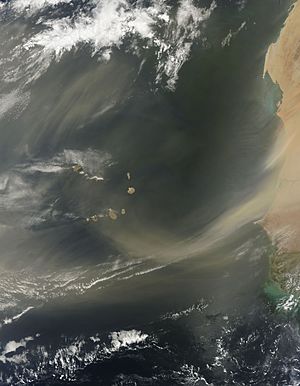Saharan Air Layer facts for kids

The Saharan Air Layer (SAL) is a huge, dry, and warm air mass. It often carries lots of dust from the Sahara Desert. This air mass floats above the cooler, wetter air over the Atlantic Ocean.
It starts in the Sahara Desert in North Africa. There, it's the main type of air, reaching high up into the sky. When this dry, dusty air moves over the ocean, it rises above the heavier, moist air near the water's surface.
This creates something called an inversion. An inversion means the air temperature actually gets warmer as you go higher up. The boundary between the SAL and the cooler ocean air acts like a lid. This lid stops any clouds or storms from forming in the air below it.
Inside the Saharan Air Layer itself, the air gets cooler very quickly as you go higher. This is because the air is so dry.
Contents
What is the Saharan Air Layer?
The Saharan Air Layer, or SAL, is a large area of very dry and warm air. It forms over the Sahara Desert in North Africa. This air mass often picks up a lot of dust from the desert.
When the SAL moves away from Africa, it travels over the Atlantic Ocean. It usually floats above the cooler, more humid air that is closer to the ocean's surface. Think of it like a giant blanket of warm, dry air sitting on top of cooler, moist air.
How the SAL Affects Weather
The SAL plays a big role in weather patterns, especially for hurricanes and other storms. Because the SAL is so dry, it can stop storms from growing stronger. Storms need moist air to develop and get bigger.
The warm, dry air of the SAL also creates a strong temperature difference. This difference can make it harder for clouds to form and grow tall. This is why areas under the SAL often have clear skies.
Dust and the SAL
The Saharan Air Layer is famous for carrying vast amounts of dust. Strong winds over the Sahara Desert lift tiny dust particles high into the atmosphere. These dust particles then travel thousands of miles across the Atlantic Ocean within the SAL.
This dust can make sunsets look very colorful. It can also affect air quality in places far away, like the Caribbean and the United States. Scientists study this dust to understand how it impacts climate and ocean life.
Images for kids
-
Dust off Western Africa in 2020
-
Dust particles can be seen as far as Cuba
See also
 In Spanish: Capa de aire sahariana para niños
In Spanish: Capa de aire sahariana para niños






